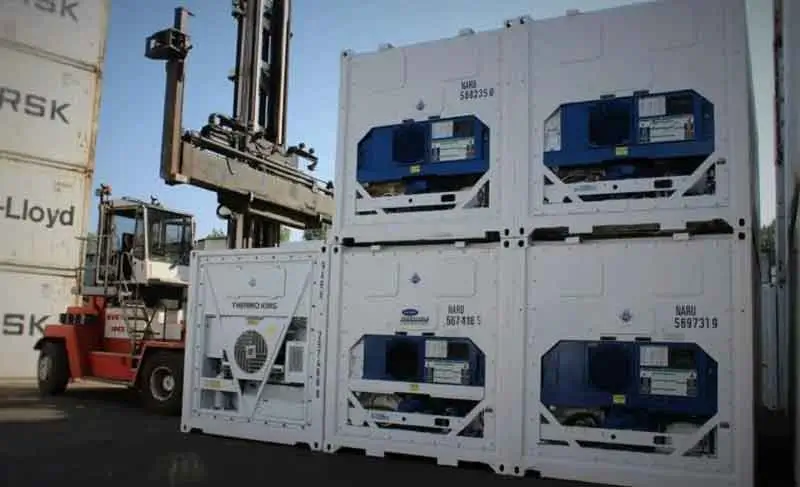This guide covers the basics of reefer container, how they work, their expected costs, and best practices to keep your products in perfect condition.
Quick summary
- Cargo types: Fresh produce, meat, dairy, frozen seafood, vaccines, temperature-sensitive chemicals.
- Temperature range: Typically -30°C to +30°C (-22°F to +86°F), ±0.5°C accuracy.
- Common sizes: 20ft (28–29 m³) and 40ft/40HC (58–67 m³).
- Cost factors: Base sea freight, electricity (“plug-in”) fees, monitoring, pre-cooling, port handling, demurrage/detention.
- Key risks: Power outages at terminals, improper pre-cooling, condensation damage, and customs delays.
What is a reefer container?
A reefer container, short for “refrigerated container,” is a specialized ISO shipping container designed to keep the cargo at a specific temperature during transit. Unlike standard dry containers, reefers use an integrated refrigeration unit powered by external electricity at ports, vessels, and trucks.
When you must use a reefer:
- Transit time exceeds 24–48 hours without guaranteed cold chain shipping.
- Cargo value loss rate exceeds 2% per °C deviation (usual in fresh produce).
- Compliance requires it (e.g., USDA for US meat imports, EU GDP for pharma).
How do refrigerated shipping containers work?
A reefer container works like a large mobile fridge/freezer. It uses:
- Refrigeration unit:Usually from Carrier, Thermo King, or Daikin; powered by 380–460V, 3-phase supply.
- Airflow & ventilation:Floor T-bars ensure cold air circulation under pallets. Vent settings adjust for ethylene-sensitive produce.
- Humidity control: Some models manage relative humidity (RH) between 60–95%.
- Pre-cooling: Cool both the cargo and the container to the setpoint before loading.
- Power sources:
- Ship’s onboard sockets at sea.
- Terminal plugs in ports.
- Diesel generator (genset) for truck/rail haul.
- Temperature recording: Data loggers or integrated controllers store temp data for download at arrival.
Tip from ASLG: At Chinese ports like Yantian, always book early and check the plug-in queue before the 5 PM cut-off. Because late arrivals risk overnight unplugged storage.

Common sizes & specs of reefer container
| Measurement | 20ft Reefer | 40ft Reefer | 40 HC Reefer |
|---|---|---|---|
| Internal length | 17.9 ft / 5.44 m | 37.9 ft / 11.56 m | 38.0 ft / 11.58 m |
| Internal width | 7.5 ft / 2.29 m | 7.5 ft / 2.28 m | 7.5 ft / 2.29 m |
| Internal height | 7.5 ft / 2.27 m | 7.4 ft / 2.25 m | 7.9 ft / 2.40 m |
| Max payload | 27,400 kg / 60,417 lbs | 27,700 kg / 61,079 lbs | 29,520 kg / 65,080 lbs |
| Capacity (CBM) | 999 cu ft / 28.3 m3 | 2,093.3 cu ft / 59.3 m3 | 2,380 cu ft / 67.3 m3 |
| Power supply | 380�C460V/3-phase | same | same |
| Common use | Small batches of fresh produce, pharma | Mixed loads, frozen seafood | Large volume produce, CA/MA cargo |
What can and can’t go in a reefer?
Suitable cargo for a refrigerated shipping container:
- Fresh fruit & vegetables (bananas, grapes, avocados)
- Meat, poultry, seafood
- Dairy products
- Vaccines, insulin, blood plasma
- Chemicals requiring stable temps (e.g., adhesives, resins)
Not suitable/restricted:
- Cargo generating excessive heat (e.g., fresh asphalt products)
- Non-packaged corrosive chemicals
- Cargo with a condensation risk that can damage machinery
Packing & palletizing tips:
- Leave clearance of 7–10 cm from container walls for airflow.
- Use shrink-wrap with vent holes for produce.
- ISPM-15 compliant pallets for international shipments.
Reefer container shipping cost: How to calculate
Formula:
Total Cost = Base Ocean Freight + Cold Plug-In Fees + Monitoring + Pre-Cooling + Port Charges + Genset Rental
Estimated example: 40–foot reefer container from China to USA (Jul 2025):
| Item | Cost (USD) |
|---|---|
| Base sea freight | 4,200 |
| Plug-in (Yantian) - 2 days x $35/day | 70 |
| Temperature monitoring | 60 |
| Pre-cooling | 120 |
| Terminal handling | 350 |
| Genset rental - 2 days x $50/day | 100 |
| Total | 4,900 |
Tip: Electricity surcharges in EU ports (e.g., Rotterdam, Hamburg) can be 30–40% higher than in US ports.
Case study: Blueberry shipment from Xiamen to Los Angeles
Cargo: 20,160 kg of fresh blueberries, packed in 2.5 kg trays, eight trays per carton, on 20 pallets.
Container: 40-foot reefer shipping container, set at +1°C, 90% RH.
Route: Xiamen → Yantian (consolidation) → Los Angeles (direct call).
Timeline:
- Factory pick-up: 14 May 2025
- Port CY cut-off: 15 May 2025
- ETD: 17 May 2025
- ETA: 31May 2025
- Final delivery: 02 June 2025
Costs:
- Ocean freight: $4,800
- Port Plug-in: $220 (2 days)
- Monitoring: $400 (14 days)
- Trucking with Genset: $280
- Insurance: $310
Performance:
- Average temp deviation: ±0.3°C
- No spoilage detected
- Client feedback: “Delivered with 0.9% shrinkage—well below target.”
Compliance and documents
| Cargo | Main Compliance | Required Docs |
|---|---|---|
| Meat/Seafood to US | USDA/FDA | Health cert, prior notice |
| Pharma to EU | GDP Guidelines | Temp mapping, stability data |
| Chemicals | IMDG Code | MSDS, hazard labels |
Conclusion
Shipping perishable cargo from China demands control at every step. Airsupply manage your reefer shipments end-to-end. From pre-cooling at the factory to plug-in at the port and final delivery, we keep your cargo fresh, safe, and compliant.
We handle refrigerated container shipping from China weekly. You can choose different sizes of refrigerated shipping containers based on your cargo volume. We also provide PTI (Pre-Trip Inspection) for all containers. Every container we deliver meets legal and safety requirements, including overseas approvals and certificates.
FAQs about refrigerated shipping container
1. How long can perishable cargo stay in a reefer?
Shelf life depends on cargo and temperature. For example, frozen shrimp at -18°C maintains quality 21–28 days. Use a temp curve to monitor deviations.
2. Is power supply available at transshipment ports?
Yes. Most major ports (Singapore, Rotterdam, Panama) provide plug-in points. Queues can last 30–90 minutes, especially during peak seasons.
3. Can I mix different cargo types in one reefer container?
Only if the temperature and humidity requirements match; otherwise, separate containers are needed.
4. What happens if power fails mid-transit?
Backup gensets are recommended. Minor outages (less than 3 hours) usually do not damage properly pre-cooled cargo.
5. How soon should I request a reefer quote?
At least 7–10 days before shipment. It ensures container availability and proper pre-cooling scheduling.
6. How do I track a refrigerated container shipment from China?
Use the carrier’s portal or your freight forwarder’s system. Check temperature, location, and ETA in real-time.




